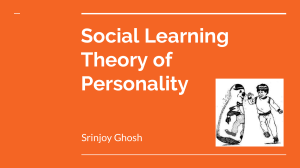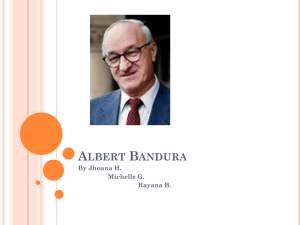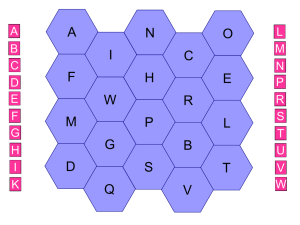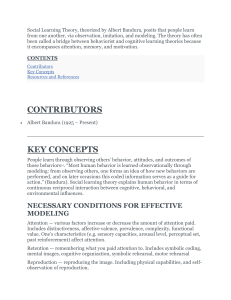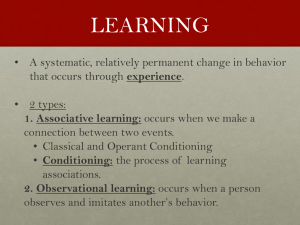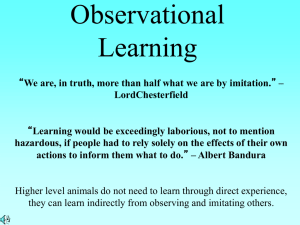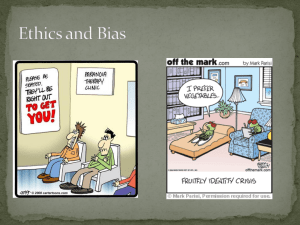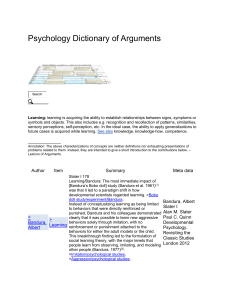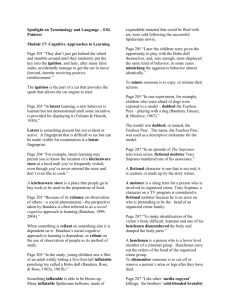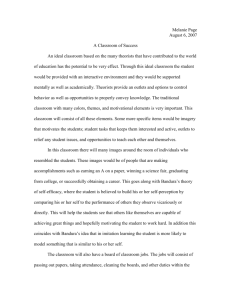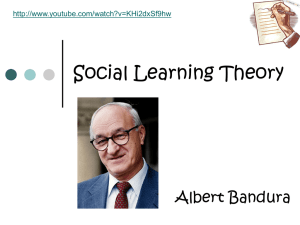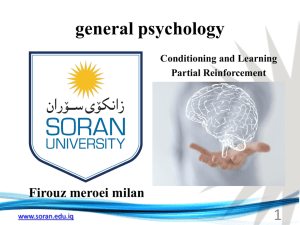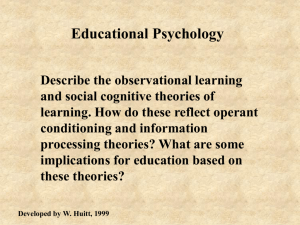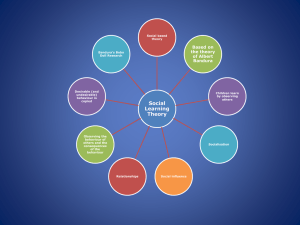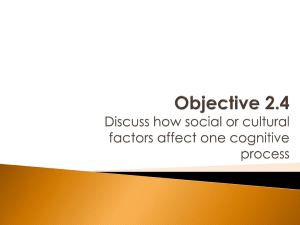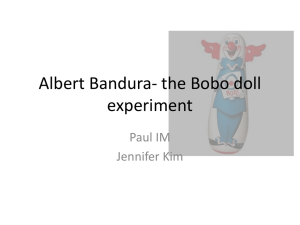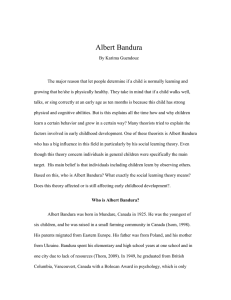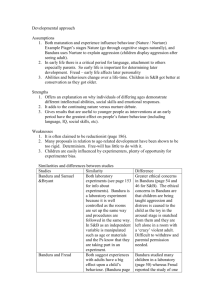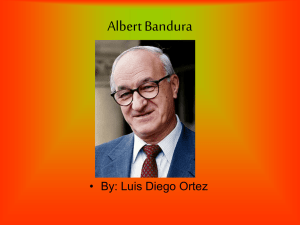Social Learning Theory ( Bandura)
advertisement
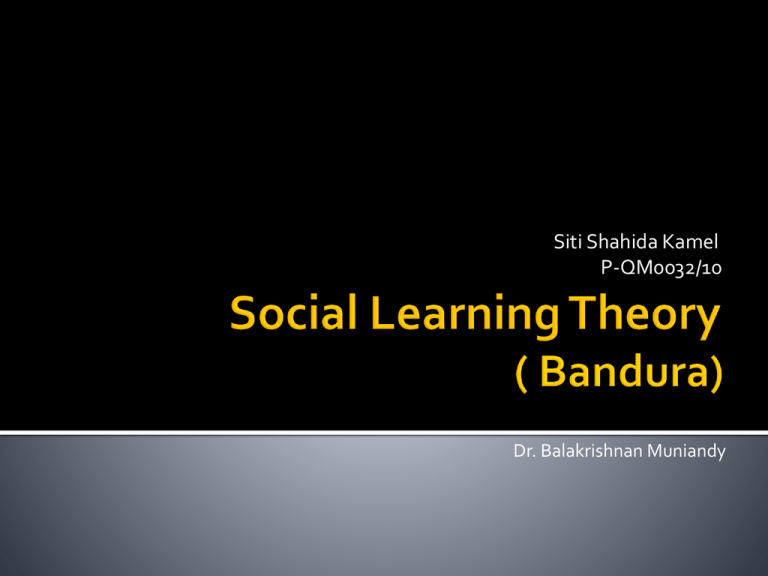
Siti Shahida Kamel P-QM0032/10 Dr. Balakrishnan Muniandy “ Learning would be exceedingly laborious, not to mention hazardous, if people had to rely solely on the effects of their own actions to inform them what to do. Fortunately, most human behavior is learned observationally through modelling : from observing others one forms an idea of how new behaviors are performed and on later occasions this coded information serves as a guide for action” Born December 4, 1925 in Mundare, Alberta, Canada as the youngest child, and only son in a family of eight. Bandura is Ukrainian and Polish descent. After finishing high school, worked in the Yukon to protect the Alaska Highway against sinking. Later credited his work in the northern tundra as the origin of his interest in human psychopathology. Received his bachelors degree in Psychology from the University of British Columbia in 1949. Went on the University of Iowa, where he received his Ph.D in 1952. It was there that he came under the influence of the behaviorist tradition and learning theory. While at Iowa, he met Virginia Vans, as an instructor in the nursing school. They married and later had two daughters. After graduating, he took a postdoctoral position at the Wichita Guidance Centre in Kansas. In 1953, he started teaching at Stanford University. While there, he collaborated with his first graduate student, Richard Walters, resulting in their first book, Adolescent Aggression, in 1959. Bandura was president of the APA in 1973, and received the APA’s awards for Distinguished Scientific Contributions in 1980. He continues his work at Stanford to this day. Bandura’s Social Learning Theory posits that people learn from one another, via observation, imitation, and modelling. The theory has often been called a bridge between behaviorist and cognitive learning theories because it encompasses attention, memory, and motivation. His theory added a social element, arguing that people can learn new information and behaviors by watching other people. Behaviorism, with its emphasis on experimental methods, focuses on variables we can observe, measure, and manipulate. In the experimental method, the standard procedure is to manipulate one variable, then measure its effects on another. All this boils down to a theory of personality that says that one’s environment causes one behavior. Bandura found this a bit too simplistic for the phenomena he was observing, aggression on adolescents, so decided to add a little something to the formula : He suggested that environmental causes behavior, true, but behavior causes environmental as well. He labelled this concept reciprocal determinism : The world and a person’s behavior cause each other. 1) People can learn through observational Observational Learning : In 1961 Bandura conducted a controversial experiment known as the Bobo doll experiment ( egg-shape ballon creature with a weight in the bottom that makes it bob back up when you knock him down) to study patterns of behavior associated with aggression. A film of a women beating up a Bobo doll shown to groups of kindergarten. Later when they were let out to play, in the playroom of course a brand new Bobo doll. As a result, the kids imitated the young lady in the film. 2) Mental states are important to learning External, environmental reinforcement was not the only factor to influence learning and behavior. Intrinsic reinforcement as a form of internal reward, such as pride, satisfaction and a sense of accomplishment emphasis on internal thoughts and cognitions helps connect learning theories to cognitive development theories ( social cognitive theory ). 3) Learning does not necessarily lead to a change in behavior While behaviorist believed that learning led to a permanent change in behavior, observational learning demonstrates that people can learn new information without demonstrating new behavior. 1 ) Attention : If you’re going to learn anything, you have to pay attention. If, for example, you are sleepy, you will learn less well. 2) Retention : Remembering what you paid attention to. When so stored, you can later bring up the image or description and reproduce it with your own behavior. 3) Reproduction : Reproducing the image. 4) Motivation : Having a good reason to imitate. Example : Television commercials – Commercial suggest that using a particular hair shampoo will make us popular and win the admiration of attractive people. Depending upon the component processes involved ( such as attention or motivation ), we may model the behavior shown in the commercial and buy the product being advertised. Bandura, A. (1997). Self Efficacy : The exercise of control. New York : W.H. Freeman. Bandura, A. (1986). Social Foundations of Thought and Action. Englewood Cliffs, NJ : Prentice-Hall. Bandura, A. (1973). Aggression: A Social Learning Analysis. Englewood Cliffs, NJ : Prentice Hall. Bandura, A. (1977). Social Learning Theory. New York : General Learning Press. Bandura, A. (1969). Principles of Behavior Modification. New York : Holt, Rinehart & Winston.
